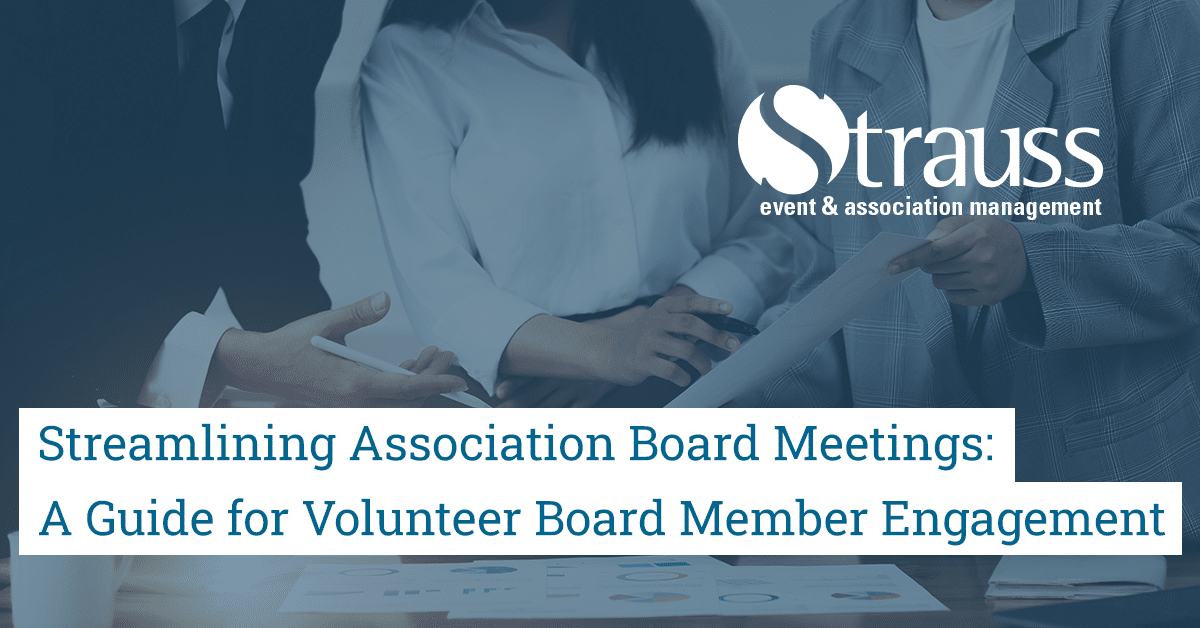Volunteers are the lifeblood of any association, dedicating their time and expertise to support the organization’s mission. As a volunteer serving on the Board, your contributions are invaluable in shaping the direction of the association. Efficient and productive Board meetings are essential to make the most of your efforts.
In this article, we will explore practical tips sourced from the team at Strauss, tailored specifically for association volunteer leaders. By implementing these strategies, you can actively participate in creating a streamlined agenda and contribute to the success of the association’s Board meetings.
-
Crafting a Streamlined Agenda:
Your time is precious, and a well-structured agenda ensures that meetings stay on track and yield fruitful outcomes. Here is how you can help create a streamlined agenda:
a) Understand the Objectives: Familiarize yourself with the goals and objectives of the meeting. This understanding will help you prioritize topics, contribute meaningfully to discussions, and keep the meeting focused.
b) Time Allocation: Work with the executive director or meeting organizer to allocate specific time limits for each agenda item. This ensures discussions do not overrun timewise and all necessary topics receive adequate attention.
c) Come Prepared: Review the agenda and supporting materials provided in advance, ideally within 24 hours of receipt. Take the time to research and gather any additional information that may be needed for the discussions. This preparation allows you to contribute informed insights and questions during the meeting.
Read more about creating a streamlined agenda here
-
Active Volunteer Engagement:
Your active participation during Board meetings brings diverse perspectives and enriches decision-making. Consider these strategies to engage effectively as a volunteer:
a) Speak Up: Do not hesitate to share your ideas, suggestions, and expertise during discussions. Your unique perspective as a volunteer can offer valuable insights and contribute to well-rounded decision-making.
b) Embrace Assigned Roles: Volunteer to take on specific roles such as timekeeper, note-taker, or facilitator, as it helps distribute responsibilities among the Board members. By actively fulfilling your role, you contribute to a smooth meeting flow and efficient logistics.
c) Follow Through on Commitments: Volunteer work extends beyond Board meetings. Be diligent in completing any action items or tasks assigned to you during the meeting. Demonstrating accountability strengthens the effectiveness of the association.
Explore more about active volunteer engagement here
-
Creating Templates for Recurring Meetings:
Recurring meetings often follow a predictable pattern. By establishing templates, you can streamline the structure and maximize efficiency. Consider these steps:
a) Identify Essential Components: Collaborate with fellow Board members to determine the recurring elements that should be included in every meeting. These may include updates on finances, committee reports, or strategic discussions. Defining these components sets a consistent framework for all meetings.
b) Efficient Time Allocation: Work together with the chief staff officer (executive director or CEO) to allocate appropriate timeframes for each agenda item. This prevents any single topic from monopolizing the meeting and ensures equal attention to critical issues.
c) Share the Meeting Template: Communicate the established template to all Board members. This allows everyone to have a common expectation for meeting agendas and contributes to a more streamlined and organized meeting.
Learn more about creating templates for recurring meetings here
-
In-person vs. Zoom Meetings:
Understanding the differences between in-person and Zoom meetings is crucial, especially as technology continues to shape the way we connect. Consider these factors when determining the meeting format:
a) Accessibility and Convenience: Zoom meetings offer convenience and accessibility for volunteers from various locations. You can participate from the comfort of your own space without the need for extensive travel.
b) Technological Considerations: Familiarize yourself with Zoom and its features. Ensure you have a reliable internet connection, a functioning microphone, and a webcam if visual participation is expected.
c) Active Participation: In Zoom meetings, be proactive in engaging and communicating your thoughts. Utilize the platform’s features effectively, such as the chat function or raising your hand, to contribute and ask questions.
Read more about the differences between in-person and Zoom meetings here
5-Preparing for Association Board Meetings:
Thorough preparation sets the foundation for productive Board meetings. Consider the following steps:
a) Review Meeting Materials: Dedicate time to thoroughly review all provided documents, reports, and materials before the meeting. This helps you understand the context, ask relevant questions, and actively contribute to discussions. Whenever possible, send questions in advance.
b) Prepare Your Insights: Take notes during your review and jot down any questions, ideas, or suggestions that arise. Bringing these to the meeting demonstrates your commitment and ensures your contributions are well-informed.
c) Confirm Attendance: As a volunteer, your presence matters. Confirm your attendance in advance, and if circumstances prevent you from attending, inform the Board chair or meeting organizer promptly. This allows for adjustments and ensures the meeting can proceed smoothly.
Discover more about preparing for association board meetings here
As a volunteer serving on an association Board, your involvement and contributions are vital to the organization’s success. By implementing the tips outlined in this article, you can actively participate in creating a streamlined agenda, engage effectively during meetings, establish critical paths for recurring meetings, choose the appropriate meeting format, and prepare thoroughly. Your commitment to efficient Board meetings will contribute to the overall effectiveness of the association and help achieve its goals.
Remember, as a volunteer, your dedication and active engagement make a significant difference in shaping the association’s future and that of your profession or industry.

